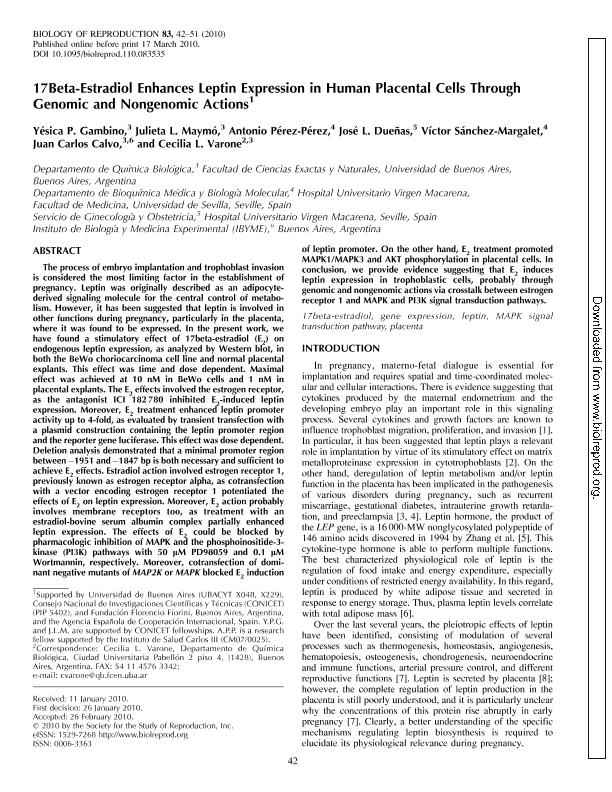Mostrar el registro sencillo del ítem
dc.contributor.author
Gambino, Yésica Paola

dc.contributor.author
Maymo, Julieta Lorena

dc.contributor.author
Pérez Pérez, Antonio
dc.contributor.author
Dueñas, José L.
dc.contributor.author
Sánchez Margalet, Víctor
dc.contributor.author
Calvo, Juan Carlos

dc.contributor.author
Varone, Cecilia Laura

dc.date.available
2018-12-20T15:30:08Z
dc.date.issued
2010-07
dc.identifier.citation
Gambino, Yésica Paola; Maymo, Julieta Lorena; Pérez Pérez, Antonio; Dueñas, José L.; Sánchez Margalet, Víctor; et al.; 17Beta-estradiol enhances leptin expression in human placental cells through genomic and nongenomic actions; Society for the Study of Reproduction; Biology of Reproduction; 83; 1; 7-2010; 42-51
dc.identifier.issn
0006-3363
dc.identifier.uri
http://hdl.handle.net/11336/66829
dc.description.abstract
The process of embryo implantation and trophoblast invasion is considered the most limiting factor in the establishment of pregnancy. Leptin was originally described as an adipocyte-derived signaling molecule for the central control of metabolism. However, it has been suggested that leptin is involved in other functions during pregnancy, particularly in the placenta, where it was found to be expressed. In the present work, we have found a stimulatory effect of 17beta-estradiol (E2) on endogenous leptin expression, as analyzed by Western blot, in both the BeWo choriocarcinoma cell line and normal placental explants. This effect was time and dose dependent. Maximal effect was achieved at 10 nM in BeWo cells and 1 nM in placental explants. The E 2 effects involved the estrogen receptor, as the antagonist ICI 182 780 inhibited E2-induced leptin expression. Moreover, E2 treatment enhanced leptin promoter activity up to 4-fold, as evaluated by transient transfection with a plasmid construction containing the leptin promoter region and the reporter gene luciferase. This effect was dose dependent. Deletion analysis demonstrated that a minimal promoter region between - 1951 and -1847 bp is both necessary and sufficient to achieve E2 effects. Estradiol action involved estrogen receptor 1, previously known as estrogen receptor alpha, as cotransfection with a vector encoding estrogen receptor 1 potentiated the effects of E2 on leptin expression. Moreover, E2 action probably involves membrane receptors too, as treatment with an estradiol-bovine serum albumin complex partially enhanced leptin expression. The effects of E2 could be blocked by pharmacologic inhibition of MAPK and the phosphoinositide-3-kinase (PI3K) pathways with 50 μM PD98059 and 0.1 μM Wortmannin, respectively. Moreover, cotransfection of dominant negative mutants of MAP2K or MAPK blocked E 2 induction of leptin promoter. On the other hand, E2 treatment promoted MAPK1/MAPK3 and AKT phosphorylation in placental cells. In conclusion, we provide evidence suggesting that E2 induces leptin expression in trophoblastic cells, probably through genomic and nongenomic actions via crosstalk between estrogen receptor 1 and MAPK and PI3K signal transduction pathways. © 2010 by the Society for the Study of Reproduction, Inc.
dc.format
application/pdf
dc.language.iso
eng
dc.publisher
Society for the Study of Reproduction

dc.rights
info:eu-repo/semantics/openAccess
dc.rights.uri
https://creativecommons.org/licenses/by-nc-sa/2.5/ar/
dc.subject
17beta-Estradiol
dc.subject
Gene Expression
dc.subject
Leptin
dc.subject
Mapk Signal Transduction Pathway
dc.subject
Placenta
dc.subject.classification
Otras Ciencias Biológicas

dc.subject.classification
Ciencias Biológicas

dc.subject.classification
CIENCIAS NATURALES Y EXACTAS

dc.title
17Beta-estradiol enhances leptin expression in human placental cells through genomic and nongenomic actions
dc.type
info:eu-repo/semantics/article
dc.type
info:ar-repo/semantics/artículo
dc.type
info:eu-repo/semantics/publishedVersion
dc.date.updated
2018-11-22T15:28:54Z
dc.journal.volume
83
dc.journal.number
1
dc.journal.pagination
42-51
dc.journal.pais
Estados Unidos

dc.journal.ciudad
Madison
dc.description.fil
Fil: Gambino, Yésica Paola. Consejo Nacional de Investigaciones Científicas y Técnicas; Argentina. Universidad de Buenos Aires. Facultad de Ciencias Exactas y Naturales. Departamento de Química Biológica; Argentina
dc.description.fil
Fil: Maymo, Julieta Lorena. Consejo Nacional de Investigaciones Científicas y Técnicas; Argentina. Universidad de Buenos Aires. Facultad de Ciencias Exactas y Naturales. Departamento de Química Biológica; Argentina
dc.description.fil
Fil: Pérez Pérez, Antonio. Universidad de Sevilla; España
dc.description.fil
Fil: Dueñas, José L.. Hospital Universitario Virgen Macarena; España
dc.description.fil
Fil: Sánchez Margalet, Víctor. Universidad de Sevilla; España
dc.description.fil
Fil: Calvo, Juan Carlos. Consejo Nacional de Investigaciones Científicas y Técnicas. Instituto de Biología y Medicina Experimental. Fundación de Instituto de Biología y Medicina Experimental. Instituto de Biología y Medicina Experimental; Argentina. Universidad de Buenos Aires. Facultad de Ciencias Exactas y Naturales. Departamento de Química Biológica; Argentina
dc.description.fil
Fil: Varone, Cecilia Laura. Consejo Nacional de Investigaciones Científicas y Técnicas; Argentina. Universidad de Buenos Aires. Facultad de Ciencias Exactas y Naturales. Departamento de Química Biológica; Argentina
dc.journal.title
Biology of Reproduction

dc.relation.alternativeid
info:eu-repo/semantics/altIdentifier/doi/https://dx.doi.org/10.1095/biolreprod.110.083535
dc.relation.alternativeid
info:eu-repo/semantics/altIdentifier/url/https://academic.oup.com/biolreprod/article/83/1/42/2530088
Archivos asociados
